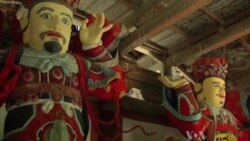HYANGSAN, NORTH KOREA —
About one quarter of South Koreans identify themselves as Buddhist, but in North Korea, which actively discourages religious practice, its popularity is less clear.
But a famous Buddhist temple in the North, dating back 1,000 years, still appears to be functioning.
There is little doubt for North Koreans whom they are to revere. Throughout the country crowds pay homage to the three generations of the Kim family with displays of devotion resembling religious fervor.
Attempts at Christian proselytizing are severely repressed. The attitude towards Buddhism, which arrived here in the fourth century, is more complicated because it is inextricably linked to Korean history.
And that history is something the single-party state promotes -- both to domestic tourists and the small number of foreigners who visit the isolated country. Pohyon Temple dates back to the Koryo Dynasty and although the Democratic People's Republic of Korea is officially an atheist country, according to the monks here this monastery and temple are still very much alive."
“I don't remember the precise number but there are about 2,000 believers of Buddhism who visit our Pohyon Temple," said Chong Byok, a Buddhist monk. "They come here for Buddhist ceremonies and to pray on Buddhist anniversaries or when they have their own events.”
Byok who has been in residence here for a quarter of a century, said he is one of 20 monks at Pohyon.
The temple itself and some of the structures on the expansive grounds, located on the slopes of the Myohyang mountains, are listed as national treasures by the government which provides funds for its operation. Donations are also welcome.
During this visit there were no obvious pilgrims seen.
Among the visitors: a large group of school children who listened as tour guides explained how half of the complex's 24 buildings were destroyed by American aerial bombings during the Korean War.
Tour guides also praise the country's founder, Kim Il Sung, for providing support for successive restorations.
But a famous Buddhist temple in the North, dating back 1,000 years, still appears to be functioning.
There is little doubt for North Koreans whom they are to revere. Throughout the country crowds pay homage to the three generations of the Kim family with displays of devotion resembling religious fervor.
Attempts at Christian proselytizing are severely repressed. The attitude towards Buddhism, which arrived here in the fourth century, is more complicated because it is inextricably linked to Korean history.
And that history is something the single-party state promotes -- both to domestic tourists and the small number of foreigners who visit the isolated country. Pohyon Temple dates back to the Koryo Dynasty and although the Democratic People's Republic of Korea is officially an atheist country, according to the monks here this monastery and temple are still very much alive."
“I don't remember the precise number but there are about 2,000 believers of Buddhism who visit our Pohyon Temple," said Chong Byok, a Buddhist monk. "They come here for Buddhist ceremonies and to pray on Buddhist anniversaries or when they have their own events.”
Byok who has been in residence here for a quarter of a century, said he is one of 20 monks at Pohyon.
The temple itself and some of the structures on the expansive grounds, located on the slopes of the Myohyang mountains, are listed as national treasures by the government which provides funds for its operation. Donations are also welcome.
During this visit there were no obvious pilgrims seen.
Among the visitors: a large group of school children who listened as tour guides explained how half of the complex's 24 buildings were destroyed by American aerial bombings during the Korean War.
Tour guides also praise the country's founder, Kim Il Sung, for providing support for successive restorations.











